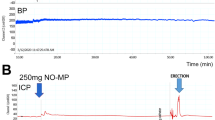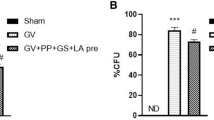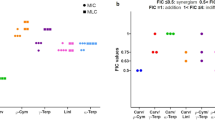Abstract
The aim of the present study was to test the effects of a topical administration of a novel nitric oxide donor, linear polyethylenimine-nitric oxide/nucleophile adduct (DS1), on vaginal blood flow and hemodynamics in rats. Laser Doppler flowmetry was used to measure blood flow changes following topical application of DS1 (0.3 or 1.5 mg in 0.15 ml saline) into the vagina of anesthetized Wistar rats. In vivo hemodynamic parameters were measured with Millar-tip-catheter placed in the left ventricle. DS1 (1.5 mg) increased vaginal blood flow by 191±24, 226±22 and 166±23% of the baseline value (at 5, 15 and 30 min, respectively, after application) without affecting systemic blood pressure, heart rate and cardiac function. The increased vaginal blood flow following DS1 application returned to baseline between 45 and 60 min. Thus, topical application of nitric oxide donors such as DS1 may be useful for the treatment of female sexual dysfunction that develops due to an impairment of local blood flow supply to the vaginal tissue.
This is a preview of subscription content, access via your institution
Access options
Subscribe to this journal
Receive 8 print issues and online access
$259.00 per year
only $32.38 per issue
Buy this article
- Purchase on Springer Link
- Instant access to full article PDF
Prices may be subject to local taxes which are calculated during checkout


Similar content being viewed by others
References
Berman JR, Adhikari SP, Goldstein I . Anatomy and physiology of female sexual function and dysfunction: classification, evaluation and treatment options. Eur Urol 2000; 38: 20–29.
Burnett AL, Truss MC . Mediators of the female sexual response: pharmacotherapeutic implications. World J Urol 2002; 20: 101–105.
Traish AM et al. Biochemical and physiological mechanisms of female genital sexual arousal. Arch Sex Behav 2002; 31: 393–400.
Goldstein I, Berman JR . Vasculogenic female sexual dysfunction: vaginal engorgement and clitoral erectile insufficiency syndromes. Int J Impot Res 1998; 10: S84–S90.
Enzlin P et al. Sexual dysfunction in women with type 1 diabetes. Diabetes Care 2002; 25: 672–677.
Rosen RC, Phillips NA, Gendrano III NC, Ferguson DM . Oral phentolamine and female sexual arousal disorder: a pilot study. J Sex Marital Ther 1999; 25: 137–144.
Vachon P, Simmerman N, Zahran AR, Carrier S . Increases in clitoral and vaginal blood flow following clitoral and pelvic plexus nerve stimulations in the female rat. Int J Impot Res 2000; 12: 53–57.
Pacher P et al. The role of poly(ADP-ribose) polymerase in the development of cardiovascular dysfunction in diabetes mellitus. Diabetes 2002; 51: 514–521.
Pacher P et al. Pharmacological inhibition of poly(ADP-ribose) polymerase may represent a novel therapeutic approach in chronic heart failure. J Am Coll Cardiol 2002; 40: 1006–1016.
Kirov MY et al. Aerosolized linear polyethylenimine–nitric oxide/nucleophile adduct attenuates endotoxin-induced lung injury in sheep. Am J Respir Crit Care Med 2002; 166: 1436–1442.
Giuliano F, Rampin O, Allard J . Neurophysiology and pharmacology of female genital sexual response. J Sex Marital Ther 2002; 28: 101–121.
Min K et al. Experimental models for the investigation of female sexual function and dysfunction. Int J Impot Res 2001; 13: 151–156.
Burnett AL et al. Immunohistochemical description of nitric oxide synthase isoforms in human clitoris. J Urol 1997; 158: 75–78.
Hoyle CH et al. Innervation of vasculature and microvasculature of the human vagina by NOS and neuropeptide-containing nerves. J Anat 1996; 188: 633–644.
Park K et al. Vasculogenic female sexual dysfunction: the hemodynamic basis for vaginal engorgement insufficiency and clitoral erectile insufficiency. Int J Impot Res 1997; 9: 27–37.
Giuliano F et al. Vaginal physiological changes in a model of sexual arousal in anesthetized rats. Am J Physiol Regul Integr Comp Physiol 2001; 281: R140–R149.
Author information
Authors and Affiliations
Corresponding author
Additional information
This study was supported by the National Institutes of Health (Grant R43HD41288).
Rights and permissions
About this article
Cite this article
Pacher, P., Mabley, J., Liaudet, L. et al. Topical administration of a novel nitric oxide donor, linear polyethylenimine-nitric oxide/nucleophile adduct (DS1), selectively increases vaginal blood flow in anesthetized rats. Int J Impot Res 15, 461–464 (2003). https://doi.org/10.1038/sj.ijir.3901045
Received:
Revised:
Accepted:
Published:
Issue Date:
DOI: https://doi.org/10.1038/sj.ijir.3901045
This article is cited by
-
Treatment of blood flow abnormality using mucosal delivery of nitric oxide
Drug Delivery and Translational Research (2011)
-
Potential future options in the pharmacotherapy of female sexual dysfunction
World Journal of Urology (2006)



